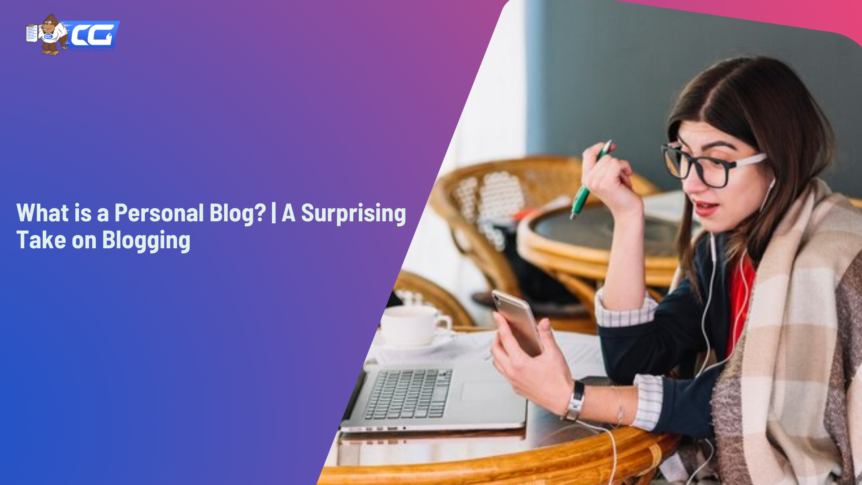Do you have a lot to share with the world? We all have stories, ideas, experiences, and knowledge that deserve an audience. Yet, so many of us keep those thoughts and passions to ourselves. This way, we lose not only the chance to share our story/ experience with others but also to inspire them, build meaningful connections, and even make money. What’s the way to deal with it, you ask? Why, a personal blog, of course! Now, what is a personal blog, and how do you start one?
Source: Freepik
It’s the best way to build your strong online presence, of course! Paulo Coelho puts it rightly, “Writing means sharing. It’s part of the human condition to want to share things, thoughts, ideas, and opinions.” Today we’ll explore what personal blogs are and what having your own personal blog means. After that, we’ll discuss why it matters and how to create one!
Understanding What Is a Personal Blog

Source: Freepik
Let’s get started by answering the simplest question, “What is a personal blog?” A personal blog is a space where you can freely express your unique and authentic perspectives. It’s like your virtual journal – intimate, expressive, and uniquely yours.
Why having a personal blog matters
Source: Freepik
There are many compelling reasons for starting a personal blog. For instance, it helps you:
- Share your valuable knowledge and make an impact.
- Preserve personal experiences and memories over time.
- Learn constantly and upgrade through writing and interaction.
- Create a strong online presence, showcasing professional expertise.
- Build a community around shared interests and create networking opportunities.
- Generate revenue through monetizing (advertising or sponsorships).
How to choose topics for a personal blog
What article topics should I cover in my personal blog? It’s a common query that bloggers often ponder over. There are tons of interesting article topics that you can write about in your own blog. We’ll keep it pretty straightforward. Whether it’s food fun, travel adventures, fitness workouts, business expertise, or personal growth, write about what gets you excited.
Quick Tip: Here’s a simple formula to evaluate this. Write down the blog niches you’re interested in. Filter out what fits your + your readers’ interests the best; that’s your ideal niche.
Essential Elements of a Killer Personal Blog

Source: Freepik
The following 11 essential elements form the basis of a killer personal blog.
1. Header section
The header section is at the top of your blog. It typically displays your logo, blog’s name, and navigation menu. It’s the first thing visitors see when they visit your blog. So, it should be clear and engaging.
2. Category menu
It’s a dropdown menu that organizes your blog’s content into specific categories. That’s so, the readers can browse and find the pages or posts that interest them. For example, lifestyle blogs for women can include general (e.g. fashion) or specific (e.g. street style, casual) categories.
3. Search function
The search function lets visitors search for and quickly find specific keywords or phrases within your blog. It’s a handy tool that enhances accessibility and user experience by helping readers find the information they need instantly.
4. Blog posts
Blog posts are the heart of any blog! They are individual articles or entries usually arranged in reverse chronological order. Bloggers write them to share their experiences or insights with readers. Remember, engaging, informative, and well-written posts keep readers hooked.
5. Comment section
Your blog’s comment section is no less than an asset containing valuable feedback. It allows readers to interact with your posts. They can leave comments, ask questions, or share their thoughts. This interaction fosters engagement and encourages reader discussion.
6. About page
The About page is another important section in a personal blog that introduces you and your blog to visitors. Here, you tell your story, background, mission, and what readers can expect. Keep it compelling to connect with readers on a personal level.
7. Striking visuals
Interestingly, a blog post with 7+ images is 2.3x more likely to win more engagement. Eye-catching graphics and multimedia elements make your blog more appealing. They break up the text, illustrate important points, enhance the blog’s overall aesthetic, and engage readers.
8. Sidebar view
The sidebar is a vertical column on either side of the blog’s main content. It typically features categories, recent/ popular posts, social media links, and sometimes ads. It’s a great way to showcase additional content resources without cluttering the main content space.
9. Related posts
Related posts are suggested articles generally linked at the end of a blog post. They help keep readers on your site longer by directing them to similar content they might find interesting. This increases engagement and page views.
10. Contact information
Contact information provides a way for readers to get in touch with the blog’s author. This can include an email address, contact form, or other contact details. It’s crucial to build relationships and allow for feedback or inquiries.
11. Footer area
The last section in a personal blog is the footer area. It sits at the blog’s bottom and provides additional navigation options. It often includes links to important pages like copyright information, privacy policy, terms of use, newsletter signup, or social-media-linked icons.
Put this all together and take inspiration from these examples of personal blogs to create yours effortlessly!
How to Create a Personal Blog to Be Proud Of

Source: Freepik
Nadalie Bardo, a blogger, emphasizes the importance of goal setting in blogging really well. She says, “Without goals, you’re just throwing spaghetti at the walls hoping that it will stick.” Let’s discuss the 5 important goals in setting up your personal blog.
Select a domain name and hosting service.
The first step to setting up your blog is to pick a relevant, unique, and memorable domain name reflecting your blog’s niche. Second, choose a reliable hosting service like Bluehost, HostGator, or SiteGround.
While choosing, check out their reviews from G2/Capterra to ensure that they guarantee uptime, affordable plans, and excellent customer support. Remember: fast, dependable hosting improves user engagement and SEO.
Design captivating logos and graphics
Next, you need to decide on the personal blog design to enhance the look and feel of your blog. Explore these ready-to-use personal blog templates to save you hours of design work. As for logos, simpler ones usually perform better than complex ones.
Use tools like Canva, Adobe, or Designhill, or hire a professional designer to create a visually appealing and scalable logo for your blog. Lastly, consider using well-thought-out graphics on your blog. Not surprisingly, quality visuals increase page views by 94%.
Build the layout and user experience
Think about how visitors navigate your blog. Plan and design a clean, intuitive layout for a smooth browsing experience. Put simply, make it easy to find what the readers are looking for with a clear layout and seamless navigation.
A user-friendly interface encourages them to stay longer and explore more, helping you get their undivided attention. Prioritize mobile responsiveness as 54.8% of website traffic comes from mobile devices.
Craft an effective content strategy
It’s time to decide what kind of content you’ll create and plan out a schedule. Research topics that resonate with your target audience and keep them engaged. To get unlimited SEO-friendly and trendy ideas, try using our Free Blog Post Idea Generator.
Leverage this tool to develop a content calendar outlining popular topics, relevant keywords, and a publishing schedule. When you’re ready to start a personal blog, decide what to write in your first blog post. Regularly post high-quality, relevant content that provides value to your readers.
Grow and monetize your blog
According to John Crew, “Making money from blogging requires you to do only two things: drive a lot of traffic, then maximize the income from that traffic.” Once you build noteworthy traffic and grow your blog, consider monetizing it.
Promote your blog on social media and engage with readers. Over time, explore monetization options like ads, affiliate marketing, and sponsored posts. Do you know you can earn between $100-$25,000/sponsored post. Why not make the most of it?
FAQs
Are personal blogs profitable?
Yes, personal blogs are profitable with the right content and monetization strategies.
Is it good to blog about my routine life?
Blogging about your routine life is a great idea to attract readers if you share unique experiences with captivating storytelling.
Should I make an Instagram account for my personal blog?
Of course! Creating an Instagram account for your personal blog helps expand your blog’s reach and engagement.
Final Thoughts
As the general saying goes, ‘Rome wasn’t built in a day’. This applies to your personal blog as well. Now that you know what a personal blog is, create one for yourself and put in the time and effort. Craft and publish valuable content consistently. It usually takes months to rank your blog in SERPs. However, a well-crafted blog can achieve this feat in no time!

I am a full-time online marketer, for over a decade now. Helped over 100,000+ people & generated well over $12M in online sales.

